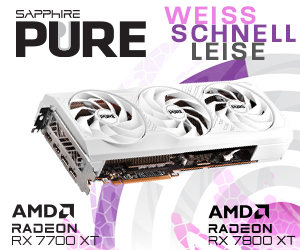This time it was Asus and the ears of the buyer, who had purchased an Asus RTX 4080 TUF Gaming just over a year ago. Why did I even bother with the root cause research and repair? As always, it’s a bit down to my curiosity and the fact that I find it hard to say no in justified damage situations once something has triggered me. The affected user from the Computerbase forum wrote to me politely and I usually reply promptly if my work allows it – regardless of whether it concerns my own community or someone else.
Of course, each of these actions (it’s not the first) is always linked to a personal background story of the respective buyer. Let’s put it in a nutshell: If a buyer with little experience puts together a new PC and also assembles it himself, then believes he has to replace or rebuild further (expensive) components because the supposed lack of airflow or an incorrect configuration leads to the graphics card permanently snapping, then his sense of justice is also tickled a little here. Because the new price of around 1500 euros and the Asus advertising with a “cool and whisper-quiet” card are in stark contrast to the result achieved.
After the airflow of the computer had been optimized several times, we came to the conclusion that it must be the most expensive part of the whole construction, which failed terribly from day one. Not completely, but with a considerable hindrance, which gradually became even worse. However, this card was never really whisper-quiet and not cool enough either. This was due to the extremely high hotspot temperatures of sometimes over 100 °C in the stress test. I can spoil the fact that I managed to drive the card to an emergency shutdown in the closed case. But more on that on the next page, because I also logged everything first and compared it with a much cheaper card.
But Asus support is there for such hardware ailments (and unfortunately also the ever-popular text modules). In any case, the customer had logged the temperatures (up to 100 °C even in the stress test) and then contacted Asus directly after just over a year, exasperated and with the onset of tinnitus. I will now shorten the correspondence a little and only quote the last two emails. First, the customer’s penultimate email to Asus, in which they had already pointed out that up to 105 °C was supposedly fully within the permissible range:
i would like to emphasize that the card reaches a hotspot of 90 degrees even if it is only operated with a load of 270 watts, which does not even correspond to 100% of its performance. In addition, the fan curve becomes considerably louder at a load of 100% to prevent the hotspot from rising above 100 degrees Celsius; the standard fan curve exceeds the 100 degree mark as the normal temperature remains at a maximum of 70 degrees.
After contacting some owners of the Asus Tuf model, I was told that the “good” cards have a maximum hotspot of 70-80 degrees Celsius, with a difference of about 10 degrees to the normal operating temperature. In comparison, the difference with my card is up to 30 degrees.
Some of these owners have had similar problems and have either sent their cards in or disassembled the cooler to replace the thermal paste and pads. However, this is not an option for me as my graphics card is still under warranty.
I have to admit that I am a little disappointed as I paid €1500 for a graphics card from a reputable manufacturer that advertises that it runs cool and quiet. Unfortunately, my card does not meet these expectations.
I have already checked the airflow in my case and found that 7x 140mm radiators provide sufficient cooling. However, there was no improvement when I removed all the panels.
Therefore, I would like to know if it is possible to send the graphics card in for inspection to identify the problem and possibly find a solution.
After that, I barely received one last email from Asus before the customer decided to contact me directly after getting nowhere in another forum:
Thank you for your feedback.
As I have already informed you, the hotspot temperature is free up to 105 degrees and the hotspot temperature is 90 degrees and the normal temperature is 70 degrees.
You can return the graphics card to your dealer for inspection. Your dealer will take care of sending it to the Asus repair center where it will be tested. If 24 months have not yet passed since the date of purchase, the warranty is always handled by the dealer, as the device is still covered by the dealer’s warranty for the first 24 months.
If you have any further questions, you can contact us at any time by replying to this e-mail.
In fairness to Asus, however, I must add that it is permitted to open the card. As a retailer, Cyberport would probably have been willing to talk to me, but I didn’t have enough time to endure more than 30 minutes on hold. According to Asus, the card would have been sent to the test lab. But since Asus support had already deemed even 105 °C to be normal, the customer simply wasn’t sure whether a new attempt, including the necessary time without using the card, would really have made sense. And that’s where I came in.
Now you have to know that the fans spin at almost 90% at 105 °C and that’s really not reasonable for anyone, not even Asus’ biggest enemy, if it really exists. And that’s exactly why I said yes and completely disassembled the test model after a very thorough test. With interesting results, but I won’t spoil anything just yet. Powercolor had already put adhesive strips of the memory pads between the GPU and heatsink (forgotten), but this was a completely different case.
ASUS TUF Gaming GeForce RTX 4080 SUPER OC, TUF-RTX4080S-O16G-GAMING, 16GB GDDR6X, 2x HDMI, 3x DP (90YV0KA0-M0NA00)
 | Lieferzeit 3-6 Werktage | 1219,99 €*Stand: 29.04.24 23:00 |
| nullprozentshop.de | siehe Shop | 1249,00 €*Stand: 30.04.24 03:21 |
 | Sofort lieferbar, Lieferzeit max. 1-3 Werktage | 1249,00 €*Stand: 30.04.24 02:40 |
KFA2 GeForce RTX 4080 SG (1-Click OC), 16GB GDDR6X, HDMI, 3x DP (48NZM6MD6LSK)


































135 Antworten
Kommentar
Lade neue Kommentare
Veteran
Urgestein
Veteran
Urgestein
Urgestein
Urgestein
Urgestein
Urgestein
Urgestein
1
Urgestein
1
Urgestein
Urgestein
Urgestein
Mitglied
1
Urgestein
Urgestein
Alle Kommentare lesen unter igor´sLAB Community →